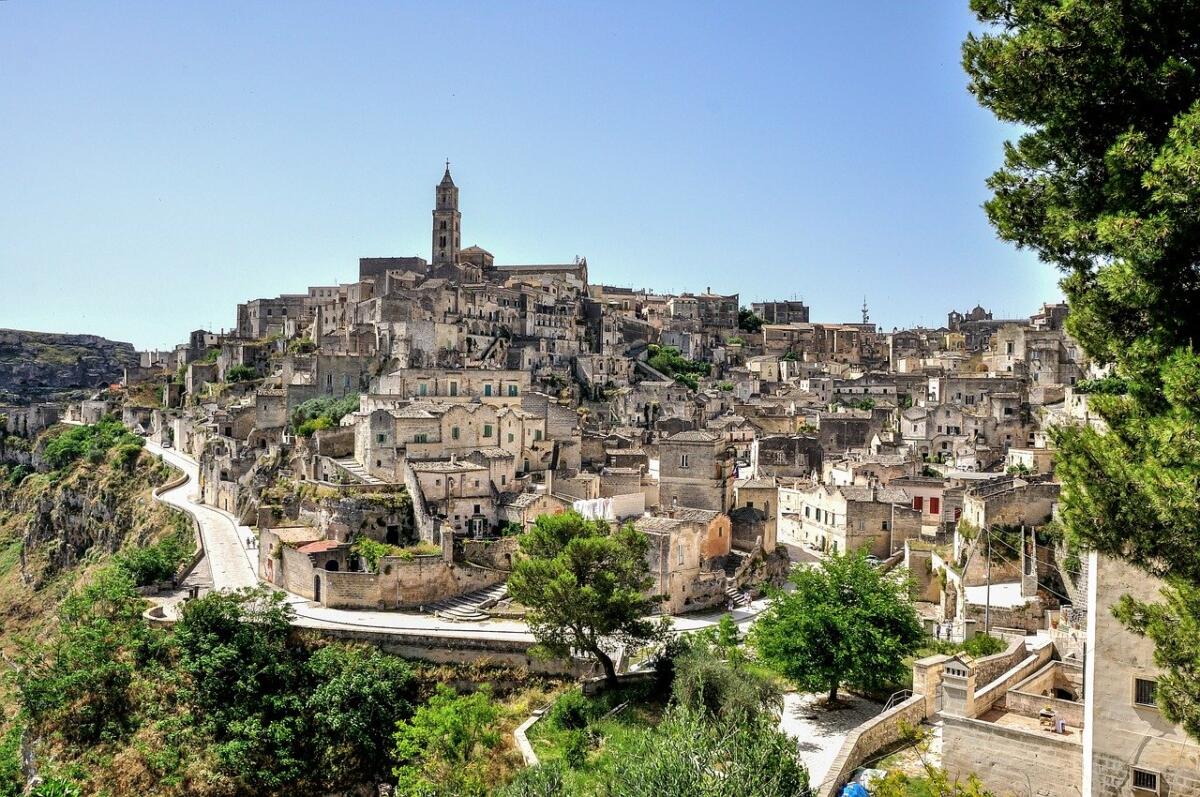
 Matera is a unique city in southern Italy, to the point that it has been declared the European capital of culture in 2019. Its peculiarity is the area called Sassi where people have lived continuously, from the Paleolithic to the present day, on a slope in caves carved into the rock of a ravine.
Matera is a unique city in southern Italy, to the point that it has been declared the European capital of culture in 2019. Its peculiarity is the area called Sassi where people have lived continuously, from the Paleolithic to the present day, on a slope in caves carved into the rock of a ravine.The Sassi di Matera, the complex of dwellings in the rock, are part of the UNESCO World Heritage Site.
There are many hypotheses about its name that go back to the Japigi period, an ancient local population, when it tells of a city called Mateola. What is certain that in Roman times, Pliny the Elder already calls it Mateola.
The territory has been inhabited since the Stone Age and in the Neolithic period the local population was already dedicated to agriculture, practicing sheep farming along the sheep paths of the Murge and they had begun to dig tuff with tools.
Matera and Basilicata then became part of the territories colonised by the Greeks. This is evidenced by its coat of arms with the ox and the ears of wheat which are also symbols of Magna Graecia.
The Romans took over from the Greeks, but we do not have many traces of them and we only know that in the imperial age it was part of the Kingdom II Apulia and Calabria.
After the fall of the Roman Empire, the territory became part of the Duchy of Benevento ruled by the Lombards, the so-called Langobardia Minor, in which the city of Matera was annexed in 664. The city grew and developed along the Civita plain surrounfed by walls, while the Sassi lived a parallel life.
For centuries, however, southern Italy had seen Lombards face off against the Saracen invaders. The Lombards sought allies to fight the Saracens and Matera was destroyed in 867 by the 'friendly fire' of Ludovico II, emperor of the Holy Roman Empire of Merovingian origin who had suffered a defeat in Rome by the Saracens and who sought to reach them in the south.
During this period in many caves of the Matera cliff Byzantine monks settled who introduced orthodox rites.
With the arrival of the Normans, called by the pope to eradicate the Byzantine rites, the south was divided into fiefdoms and Matera became part of the Terra d'Otranto and was assigned to Guglielmo Braccio di Ferro, whose name comes from having killed the emir of Syracuse with one hand during a battle against the Saracens.
The Normans, and then the Swabians of Frederick II, brought a period of peace and began the construction of the cathedral with its high bell tower. In fact, for this church, Matera was the seat of a diocese run by a bishop.
In the struggle between the papacy and the empire, once again the church asked for help from foreign powers and in southern Italy Charles of Anjou came who defeated the sons of Frederick II and became king of Naples.
The policies of the Angevin were not much appreciated by the people and the Aragonese of Spain arrived in southern Italy. In 1481 King Ferdinand I, the illegitimate son of Alfonso of Aragon, visited Matera and elected it as his temporary residence in the war against the Turks.
With Ferdinando II, Matera was assigned to Count Giovan Carlo Tramontano who ruled with cruelty to the point that the city rebelled and the count was assassinated in 1514, in a street later renamed Via Riscatto.
The new feudal lords respected the Matera people who enjoyed unusual freedoms for the period. At the beginning of the seventeenth century, the Schiavoni arrived in Matera. The people were fleeing the expansion of the Turks and came from an area between Serbia, Croatia and Albania. These went to live in the Sassi in an area that has since been called Casalnuovo.
From the seventeenth century there were other revolts against the Spanish sovereigns who neglected Italy and considered it only a land to be ‘milked’.
In 1663 Matera became the capital of Basilicata and this role brought it a certain well-being that is still found in the richness of the architecture of the palaces and churches.
With the arrival of Napoleon and the period of French domination, feudalism was abolished and in 1806 the capital was transferred to Potenza. But despite the end of feudal laws, the condition of the population did not change much and part of the bourgeoisie took part in both the Risorgimento uprisings of 1820 and those of 1848.
Finally there was initial support for the arrival of Garibaldi, with the hope of social justice, which also led to the assassination of Count Gattini in 1860 who was guilty of not wanting to implement social reforms.
A hope of justice having been misplaced pushed many to banditry that in Matera saw as protagonists Rocco Chirichigno di Montescaglioso, Vincendo Mastronardi di Ferrandina, and Eustachio of Fasano and Matera.
In the meantime, the Sassi di Matera were increasingly considered an unhygienic and unhealthy arrangement and an example of the underdevelopment of southern Italy.
In the 1950s, funds arrived for the construction of a new neighborhood and for a study of the city by a commission involving architects and sociologists directed by Adriano Olivetti, the brilliant entrepreneur of electronic calculators and inspirer of a new model of humanistic entrepreneurship.
The recovery of the Sassi di Matera began in the 1980s and in 1993 it was declared a World Heritage Site by UNESCO. In 2019 Matera was the European Capital of Culture.







Follow us